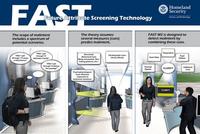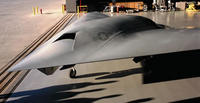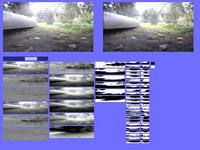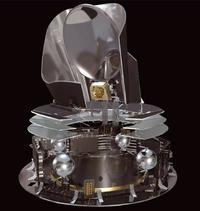-
DHS completes tests on mind reading technology

DHS officials recently completed an initial round of tests for its new intent detecting technology; with the Future Attribute Screening Technology (FAST) program, DHS hopes to be able to identify terrorists or criminals before they execute an attack; FAST relies on remote sensors to measure several physical indicators like heart rate and how frequently one’s eyes flit back and forth; so far the technology has only been tested in a laboratory setting, but DHS says that it has been able to achieve a 70 percent accuracy rate; in the next battery of tests, officials will examine how FAST fares in more realistic settings; many scientists criticize the program for the dubious science behind it
-
-
Future UAVs will emulate birds
Engineers at UC San Diego are mimicking the movement of bird wings to help improve the maneuverability of unmanned aerial vehicles (UAVs); this is important, because UAVs are quickly becoming popular tools for the armed forces, and there are also a myriad of civilian applications which are rapidly developing, such as border control, wildfire monitoring, search and rescue, and traffic observation
-
-
DARPA crowd-source next-gen UAV design
DARPA has announced its UAVForge competition for the design of a user-intuitive, backpack-portable UAV which is also quiet, can stay aloft for at least three hours, and can fly in harsh condition; in addition to the $100,000 prize, the winning team will have the opportunity to showcase its design in an overseas military exercise
-
-
Smartphone apps help thousands in latest storms
In the recent string of natural disasters to hit the Midwest, emergency communication smartphone apps have proven invaluable for contacting family members and first responders; during these natural disasters, telephone lines and cell phone towers are often inundated with traffic, leaving individuals unable to contact their loved ones or even reach 911; thanks to smartphone apps like Life360, individuals have been able to contact family members to let them know they are okay, or alert emergency workers if they are in trouble; during the floods that left Memphis, Tennessee under water, more than 2,400 families used the app to share their locations and confirm their safety
-
-
Forensic science to foiling fakers of Chinese art

The field of Chinese art has become one of the hottest sectors of the global art market in recent years, and nowhere more so than in the demand for fine antique porcelain; prices for the finest Imperial porcelain have soared, but so have the ambitions of accomplished fakers, seeking to infiltrate exquisite new fakes into a market eager for top quality material; a joint effort by university researchers and an auction house will see the application of forensic science in the authentication of Chinese artifacts
-
-
Phantom Ray completes maiden flight

Phantom Ray, Boeing’s fighter-sized unmanned airborne system (UAS), took to the early morning skies on 27 April at Edwards Air Force Base in California for its maiden flight; Phantom Ray is one of several programs in Boeing’s Phantom Works division, including Phantom Eye, which is part of a rapid prototyping initiative to design, develop, and build advanced aircraft and then demonstrate their capabilities
-
-
Portable technology provides drinking water, power to villages, military
Researchers have developed an aluminum alloy that could be used in a new type of mobile technology to convert non-potable water into drinking water while also extracting hydrogen to generate electricity; such a technology might be used to provide power and drinking water to villages and also for military operations
-
-
Michelin developing puncture-proof tires
Michelin, the French tire manufacturer, has invented the “Tweel” which could make vehicles impervious to punctures or even explosions; The Tweel is a combination tire and wheel that infuses the best elements of both designs; the Tweel has no pneumatic rubber shell leaving nothing to deflate or puncture; the Tweel resembles a wagon wheel with polyurethane spokes and rubber for the treads, but is not entirely rigid as the spokes are flexible; despite these improvements in design, Tweels have several flaws that have kept them from being widely implemented
-
-
Homeland security solution competition
HSTV announced its Ideas for a Secure Tomorrow awards — a video competition that seeks the best ideas for improving security at both the local and national level; entries are due by 1 August 2011
-
-
Researchers develop paper that is stronger than steel
Work by Australian researchers is a step forward in the development of a material that has the potential to revolutionize the automotive, aviation, electrical, and optical industries; the composite material based on graphite that is a thin as paper and ten times stronger than steel
-
-
U.S. Air Force wants mind reading aerial drones
The U.S. Air Force is currently working with several firms to develop aerial drones that have the ability to think and anticipate a controller’s actions before it occurs; the Air Force began exploring this capability in order to avoid collisions during takeoff and landings at busy airport terminals where both manned and unmanned planes launch; to address this problem, the Air Force awarded contracts to several firms to develop predictive software that can anticipate a pilot’s reaction if a drone is flying too closely
-
-
Bird-like visual sense to help UAVs navigate in urban environments

The U.S. Office of Naval Research (ONR) has awarded researchers $4.5 million to develop a bird-sized, self-flying plane that could navigate through both forests and urban environments; the plane would be about the size of a crow, and, like a bird, would use vision to navigate, but it would use orientable propellers and not flap its wings; the drone will rely, in part, on a technology that emulates the visual system of animals called Convolutional Networks, which mimics the neural network in the mammalian visual cortex and can be trained quickly to interpret the world around it
-
-
Space technology of practical uses on Earth

Terahertz technology developed for space missions to study the most distant objects in the universe is now finding a host of practical applications back on Earth; most clothing and packaging materials are transparent to Terahertz radiation, whereas skin, water, metal and a host of other interesting materials are not; this gives rise to some important day-to-day applications: detecting weapons concealed under clothing or inside parcels; distinguishing skin and breast cancer tissue; quality control of manufactures items and processes in factories
-
-
Army spends $50M for translation app that is already available

This year the Pentagon has set aside nearly $50 million for the development of a sophisticated smartphone translation app that would allow troops in Afghanistan to translate Pastho and Dari; but some troops have already begun using the SpeechTrans app to translate Arabic which can be downloaded on any iPhone or iPad for less than $20, and the New Jersey based company is hard at work on an Afghan language edition of its app; one defense analyst questions the need to spend millions on research when “good enough” technology is already available, especially in light of congressional efforts to cut the deficit
-
-
New rifle sighting system dramatically improves accuracy
Crosshairs automatically adjust for conditions in real time; a fiber-optic laser-based sensor system automatically corrects for even tiny barrel disruptions; the system, developed at Oak Ridge National Laboratory’s (ORNL), precisely measures the deflection of the barrel relative to the sight and then electronically makes the necessary corrections; the new sensor is 250 times better than that of traditional crosshairs, which can be manually adjusted by one-fourth minutes of angle; the ORNL sensor can sense angular displacement and shift the reticle (crosshairs) by 1/1,000th of a minute of angle
-
More headlines
The long view
New Technology is Keeping the Skies Safe
DHS S&T Baggage, Cargo, and People Screening (BCP) Program develops state-of-the-art screening solutions to help secure airspace, communities, and borders
Factories First: Winning the Drone War Before It Starts
Wars are won by factories before they are won on the battlefield,Martin C. Feldmann writes, noting that the United States lacks the manufacturing depth for the coming drone age. Rectifying this situation “will take far more than procurement tweaks,” Feldmann writes. “It demands a national-level, wartime-scale industrial mobilization.”
How Artificial General Intelligence Could Affect the Rise and Fall of Nations
Visions for potential AGI futures: A new report from RAND aims to stimulate thinking among policymakers about possible impacts of the development of artificial general intelligence (AGI) on geopolitics and the world order.
Keeping the Lights on with Nuclear Waste: Radiochemistry Transforms Nuclear Waste into Strategic Materials
How UNLV radiochemistry is pioneering the future of energy in the Southwest by salvaging strategic materials from nuclear dumps –and making it safe.
Model Predicts Long-Term Effects of Nuclear Waste on Underground Disposal Systems
The simulations matched results from an underground lab experiment in Switzerland, suggesting modeling could be used to validate the safety of nuclear disposal sites.
